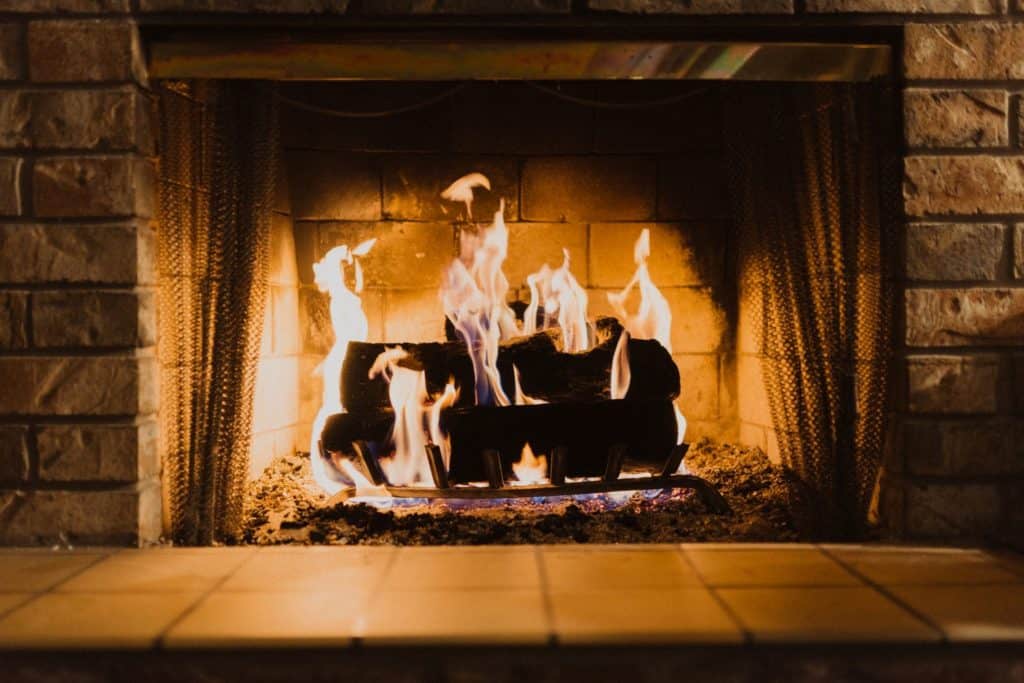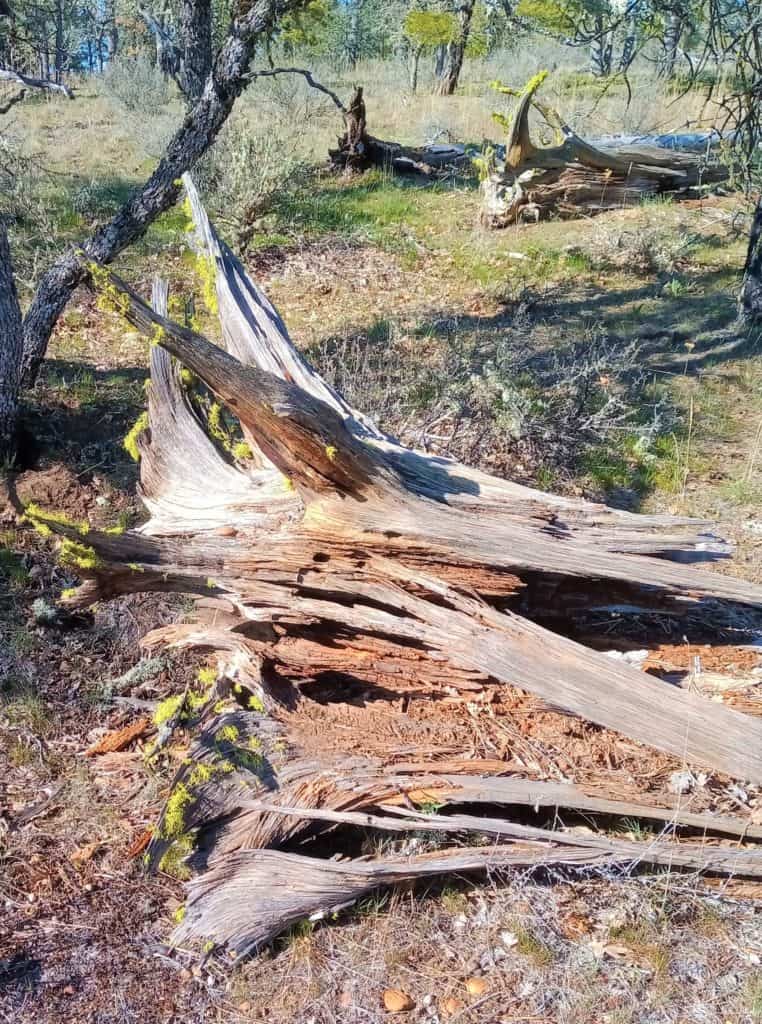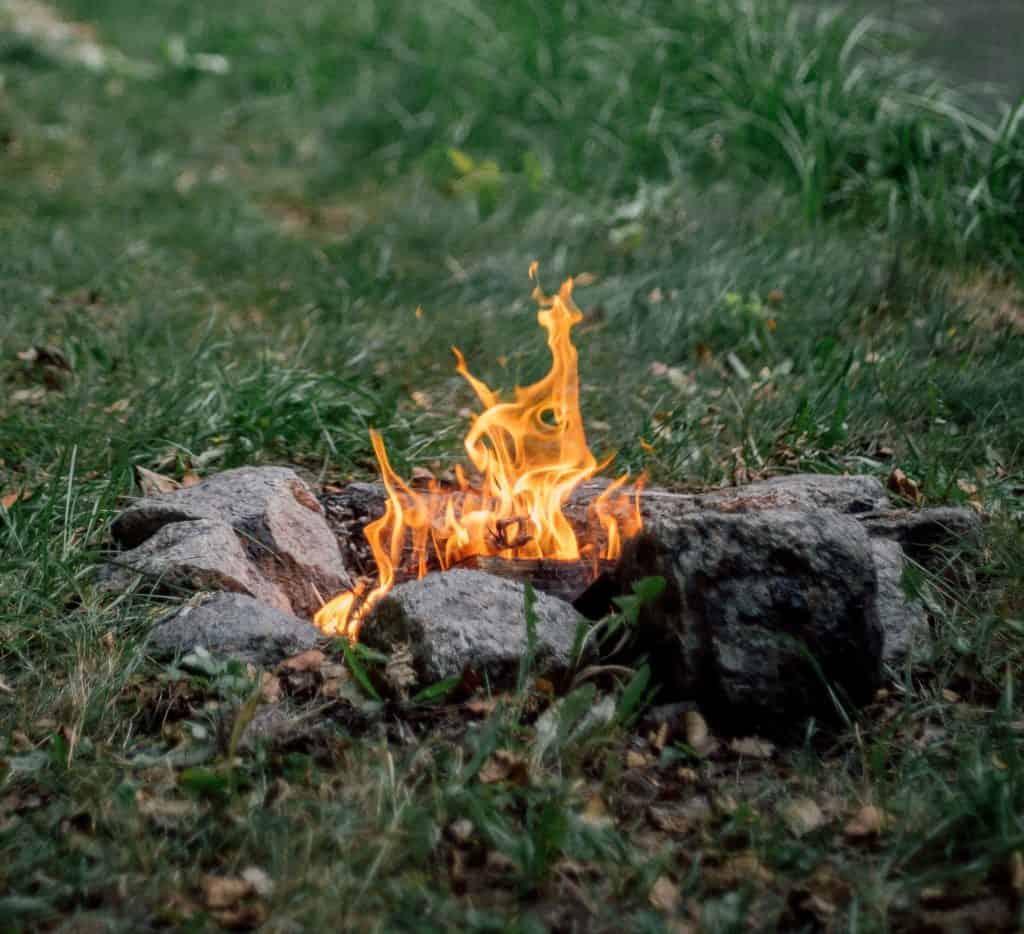
We have a lot of uprooted trees from years past. These roots get loaded with fatwood, lightwood, heart pine, lighter knot, or whatever you call it, which we use to start a fire in our wood stoves. However, burning puts off a lot of black smoke that can alarm people. There’s this stigma that black smoke equates to creosote build-up.
As a general rule, the black smoke from fatwood will not harm the chimney since it’s soot. Soot combines carbon fragments and ash that hasn’t completely burned. However, because soot is a carbon, under the right conditions and heat, it will burn off, leaving the wood’s mineral component, ash.
Burning too much soot-creating wood, such as fatwood can clog up your chimney stack, which can cause draft issues. When there’s a draft issue in a wood stove, the smoke seeks a place to escape any place it can which can mean out into the living area of a home or cabin.
Later I’ll talk about the differences between soot and creosote and what creates them.
What Makes Fatwood Burn Black Smoke?
Fatwood is wood soaked in an oily resin derived from pine pitch. This resin is a hydrocarbon that makes it flammable and naturally emits black smoke like many other oily carbons.
TIP: Don’t use fatwood, lightwood, or heart pine, as the primary fuel source for your fire in a wood stove or fireplace. The heat and smoke from fatwood put off are best used in moderation as a fire starter.
Can Fatwood Go Bad Over Time?
Fatwood will not go bad, per se, over time as long as it’s stored properly in a dry area. However, it can dry out and lose some of its combustion ability over time.
Here’s what I’ve personally experienced. As an experiment, I chopped large chunks of fatwood from the same source. I left much of it in the larger chunks while taking several other pieces and splitting them into several different sizes.
I also used some fragments to create fine shavings and small splinters. I stored each of these in the exact location in an open area. After a couple of weeks, I found that the larger pieces of the fatwood were the same. However, the smaller pieces of the fatwood had gotten dryer and lost some of the strong pine smell and tackiness.
On some of them, when I shave away some dried surfaces, the scent and tackiness returned. The fine shavings were like dried sawdust and burned like it as well. However, it didn’t ignite the same and didn’t burn near as long. I also noticed that the smoke produced wasn’t that thick black smoke either.
At the same time, I had also stored about the same amount of fatwood in an old tin box I use for tinder. With this, I didn’t touch it for almost four months. After that time, I discovered that the fine shavings felt dry; however, I could still ignite them using a Ferro rod, but requiring a lot more spark. The larger chunks and the splinters did not appear to have changed any.
My conclusion is to keep shavings from drying out and keep them dry and covered, such as in a plastic container with a lid, a sealed plastic bag, or a metal tin with a top. It doesn’t necessarily need to be airtight, but it would probably be helpful. Larger pieces of fatwood do okay, just stored in a dry place but not directly exposed to heat, such as the sun.
Can Fatwood Burn Even When it’s Wet?
Pine pitch and resin are waterproof, which makes up fatwood. Therefore, fatwood will burn when wet, and because of the heat it puts off, it can dry out and ignite more significant pieces of wood in wet conditions.
Where can Someone get Fatwood Instead of Buying it?

It’s going to depend on where you’re located. Fatwood gets formed inside mostly pine trees. So if you’re fortunate enough to live near an area with pine trees, you might be able to find your own fatwood.
When a tree dies, regardless of whether standing or not, the sap runs to the tree’s heart, which is in the center and works its way to the root system. As time goes by, that sap turns into pitch and eventually into a resin.
Some parts of the dead pine tree will have thicker and heavier concentrations of this resin that can be located where branches are used to attach to the main tree trunk.
To find the resin-soaked wood, you’ll need to cut off a portion of the branch or an exposed portion of the root system. Cut away the dry rotten part of the tree to see if there’s any fatwood. You’ll know it when you find it, as it’ll be amber or orange in color with a powerful pine scent. The wood will also be a bit tacky and have some weight to it.
What’s the Difference Between Soot and Creosote?
As mentioned before, soot is an unburned carbon fragment containing some ash. On the other hand, creosote is a very flammable substance made up of flakes, bubbly goo, or glossy-looking tar. It comes from a cold fire in a wood stove or fireplace due to burning wet or green wood, creating a severe fire hazard. It can also be relatively difficult to remove the creosote, where a brush or vacuum will clean soot build-up. Soot is a smooth powdery type of substance that’s either black or really dark brown.
To learn more about creosote read the article titled, Can I Avoid Creosote When Burning Ponderosa Pine?
Uses for Fatwood Might Include the Following

- Fire Starter – Primarily it’s used as a natural fire starter with no chemicals added. Use in moderation for starting fires in both wood stoves and fireplaces.
- Start a BBQ – Use fatwood to get briquettes or natural charcoal started on the BBQ. Careful though, a little bit will burn for quite a while. You want to let the fatwood burn completely out before adding food to the grill due to the black smoke which could create a bad taste on the food due to the soot.
- Outdoor Use – Outdoors, you can use fatwood as a natural source of light by creating a torch or a fatwood candle. Neither a torch nor a candle is something used indoors.
Not Recommended Uses for Fatwood
- Using too Much – To create a complete fire from just fatwood, especially in a wood stove or fireplace. The amount of soot from such a fire would clog up your chimney.
- Cooking Food – Don’t use it for smoking or cooking, just as you don’t use pine in smokers as it leaves a very bitter taste.
- Cooking Over the Open Flame – Like pine, if you use fatwood, use only enough to start the fire using dry woods and let it burn out, and then only cook over hot coals and embers, not over the burning wood itself.
In Summary
Using fatwood, lightwood, heart pine, or lighter knot is as pure and natural as you can get when starting a fire. However, there’s this possible temptation to use more than what’s necessary because of how well and hot it burns. Outside, burn as much as you want but in a wood stove or fireplace, limit the amount. Otherwise, you could end up with a clogged smokestack and a room full of black sooty smoke.
Thank you for reading my article. If you liked it please see other articles I’ve written.
Also, consider reading
